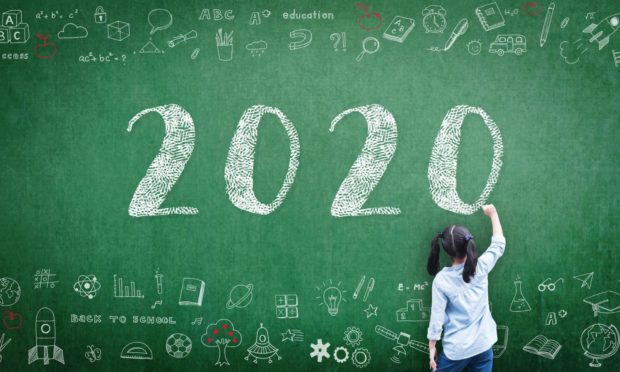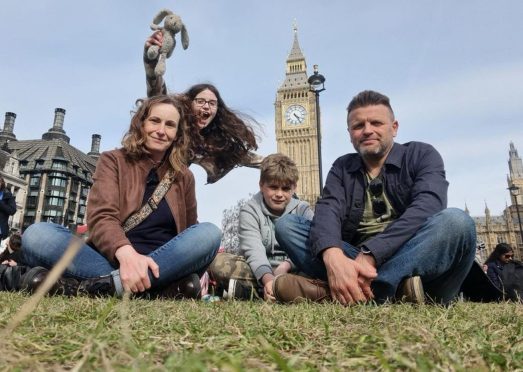Cast yourself back to this time last year and imagine someone told you schools would close for weeks on end.
Imagine someone told you exams would be cancelled. For not one year, but two in a row.
And imagine you were told schoolchildren would be wearing facemasks in classrooms.
The year 2020 became one we could never have envisaged for schoolchildren, parents, teachers and school staff.
Virus emerging
It was on December 31, 2019, that a cluster of pneumonia cases in the Chinese city of Wuhan was reported to the World Heath Organisation.
Towards the end of January cases were being reported in European countries and on January 31 the first cases in the UK were confirmed.
Come February there were the first warnings that schools may have to close, possibly for several weeks, to help curb the spread of Covid-19. We watched nervously as Italian schools were ordered to close early in March.
Schools close
It was on Wednesday, March 18 that First Minister Nicola Sturgeon confirmed that schools would indeed shut.
The next day Education Secretary John Swinney said exams were cancelled for the first time since the system was introduced in 1888.
Exams scrapped
He offered assurance the Scottish Qualifications Authority could develop a credible certification model to ensure young people were “not in any way disadvantaged”.
That Friday the bell rang for the last time and pupils were dispatched with instructions on how to log on and access lessons on laptops, tablets and mobile phones.
Emotional last day
Parents speculated at the school gates on whether or not youngsters would be back before the summer holidays, and began mentally preparing to juggle work with home schooling.
Pupils waved goodbye to teachers and classmates, excited about an ‘extended holiday’ but unsure when they would see them again.
‘It’s out of our hands now’: Emotional scenes in Fife as schools shut due to coronavirus
On Monday, March 23 Joe Wicks became the nation’s PE teacher as millions of families logged on to start months of remote learning with his first daily YouTube exercise session.
Teachers’ transformation
Teachers working from their bedrooms, dining tables and sofas, transformed the way they taught almost overnight, issuing assignments, lessons and activities through systems including Glow, Seesaw and Microsoft Teams.
Not all families were equally equipped for home learning, though, and work began to identify those in need of more support. Many teachers went out and delivered materials by hand to those unable to access work online.
Online tours
As they learned from home, pupils preparing for the big step from primary to secondary school were missing out on the visits they would normally have to acquaint them with their new school and their new classmates.
But the pandemic saw that go online too, with many schools recording virtual tours so pupils could see on screens where they would learn, eat and socialise after the summer holidays.
Milestones missed
As the last term of the 2019/20 academic year drew to a close pupils leaving primary and secondary schools missed out on end of year prize-givings, proms and celebrations. But, again, schools and parents found new ways to mark the milestones.
Meanwhile, teachers and education officers exhausted by a term like never before had been working hard to prepare for the blended learning which was planned for August’s return.
Blended learning
Classrooms were reconfigured and timetables drawn up for pupils to attend school part-time and learn at home.
But just days before the holidays it was back to the drawing board, as Mr Swinney announced on June 23 that schools were to reopen full-time for the new term.
John Swinney announces plans to reopen schools on full-time basis from August in major U-turn
Even during the holidays there was more anguish in store.
As National 5, Higher and Advanced Higher results began dropping through letterboxes on August 4 it quickly became clear all was not well.
Results misery
More than 124,000 grades estimated by teachers had been moderated down by the Scottish Qualifications Authority, and pupils attending schools in ‘poorer’ areas were disproportionately affected.
John Swinney confirms all downgraded exams results withdrawn and teacher estimates reinstated
As schools prepared to submit thousands of appeals, the Scottish Government withdrew the affected grades and reverted to those estimated by teachers.
Back to school
On August 11 children across the country began returning to school, excited to see friends and teachers they had been parted from for almost five months.
LONG READ: Back to school ‘just like Christmas morning’ for excited and nervous pupils
Neither social distancing nor, initially, face masks were required, but a new regime was in place including enhanced hygiene and one-way systems.
Younger pupils quickly adapted to staying in their playground bubbles and a ‘skoosh’ of hand sanitiser every time they entered or left their classroom.
Virus spread
Inevitably, and despite the precautions, the virus arrived in schools within days, and as cases were diagnosed in pupils or staff whole classes were asked to self-isolate.
A few schools were closed entirely, including Kingspark School, in Dundee, a school for pupil with additional support needs.
Face masks
Face masks had already become the norm in corridors of secondary schools but from November 2 they were also required in classrooms for senior pupils in Dundee schools.
New guidelines were introduced for those areas under level three restrictions, which just days later included Angus, Fife and Perth and Kinross.
Senior pupils and their teachers to wear face masks in Dundee classrooms
In October we learned that exams would again be cancelled for pupils studying for National 5s, in an attempt to protect those for Higher and Advanced Highers in May 2021.
Exams cancelled again
But on December 8 these too were scrapped – not this time on grounds of safety but on grounds of equality, as some pupils had missed weeks of school-time due to self-isolating while others had missed none.
Exams: Scottish Higher and Advanced Highers cancelled for 2021, John Swinney confirms
As the final term of 2020 drew to a close restrictions meant normal Christmas celebrations were scratched from the calendar.
Virtual Christmas
Parents could not come to see nativity shows and Christmas concerts – but again inventive teachers and pupils found a way round the restrictions to bring festive cheer.
Advent calendars were produced for schools’ social media feeds and performances were broadcast on YouTube, attracting in some cases thousands of views and far bigger audiences than would fit in an average assembly hall.
End of term
But even the end of term was up in the air.
There was pressure from teaching unions and other quarters for those schools remaining open until December 22 and December 23 to close early on December 18 on safety grounds.
The demands were resisted by the Scottish Government but rising infection rates and the threat of a new Covid variant brought another twist for schools.
Remote learning
On December 19, as a three week post-Christmas lockdown was announced, we learned there would be a return to home learning for at least a week.
So, on the final day of 2020 pupils’ return to school on January 18 remains uncertain.
The only thing that is certain is that 2021 is likely to be another turbulent year in education.










